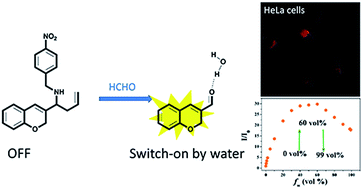A switch-on fluorophore using water molecules via hydrogen bonding and its application for bio-imaging of formaldehyde in living cells†
Abstract
Water molecules always quench fluorescence, limiting the practical application of fluorophores in bio-imaging. Probes developed from the well-established Aggregation Induced Emission (AIE) effects seem to be able to overcome this challenge. However, the background interference issue has hampered the development of the field for a long time. Herein, we report a type of fluorophore whose emission could be switched on using water molecules. The fluorophores were derived with aldehyde groups from a natural compound chromene and synthesized in just one-step. The triggering of fluorescence enhancement was not related to the well-known AIE mechanism or covalent reaction, but was further elucidated to be due to the non-covalent hydrogen bonding between the fluorophores and water molecules. Subsequently we optimized structures of the chromene derived fluorophores and chose a fluorophore for further application as a fluorescent probe. The probe showed high sensitivity and selectivity for formaldehyde. Moreover the excellent pH-, redox-, and photo-stability and low cytotoxicity guaranteed its successful imaging of formaldehyde in living cells. Our findings not only provide an example of fluorophores whose emission mechanism is complementary to the AIE mechanism, but also introduced a new type of probe for biosensing, bio-imaging and potential precise diagnosis in the future.



 Please wait while we load your content...
Please wait while we load your content...